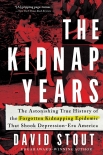The Kidnap Years:, David Stout [readict .txt] 📗

- Author: David Stout
Book online «The Kidnap Years:, David Stout [readict .txt] 📗». Author David Stout
Then, just over three months into FDR’s first term, came the Union Station Massacre, prompting the president to begin a much-publicized campaign on bank robbers, kidnappers, and killers who seemed to roam at will, especially in the Midwest. In those dark days of the 1930s, journalists had access to far less information than they do today. Government agencies and the police could dole out information—or withhold it—as they chose.
Still, by that time—no, long before—sharp journalists should have been saying to one another, “The Justice Department contradicts itself from one month to the next. It sounds like Hoover is the keeper of the secrets, cherry-picking the information he’s willing to share, even with his so-called bosses. Who’s really running the show?”
The fast-changing and conflicting accounts given by various officials, especially Hoover, were succulent, low-hanging fruit, ripe for picking by industrious reporters, not just for their own glory but for the public good. Instead, Hoover and his bureau got coverage best described as idolatry.
Occasionally, the journalists of the day became near contortionists in portraying the FBI as triumphant. Debacles were transformed into momentary setbacks that only inspired the bureau to go ever higher and further in pursuit of the truth. A reprise of the Hamm kidnapping, published in the New York Daily News on August 16, 1936, after the Justice Department had cleared up its own mess, called the eventual solution of the case “a brilliant victory—more brilliant, in a way, than any other triumph in the drive on the snatch racket, for at one time in this case the Government appeared to have been counted out… But we know now that the federal forces kept right on fighting. Their comeback bout has been a masterly one.”112
But what about the ordeal of Touhy and his friends, who were no doubt guilty of a lot of things but were innocent of the kidnapping?
“This was not a defeat for American Justice,” the article went on. “As a matter of fact, it was a magnificent triumph, for time was to prove that the Touhy mobsters had nothing whatever to do with the kidnapping of William Hamm.”
If the Touhy acquittal was a “magnificent triumph,” it was not because of the FBI. It was because of the conscientious Minnesota farmer who served as jury foreman and his fellow jurors. They saw through the government’s case. If the FBI really did manage to lift the fingerprints of Alvin Karpis and his accomplices two months before Touhy even went on trial—and the FBI boasts that it did—justice was done not because of the FBI but despite it.
*Again, the holiday was still celebrated on the last Thursday of November, not the fourth. In 1933, Thanksgiving Day fell on November 30.
**Hoover recognized the potential of fingerprint analysis early on. From the mid-1920s, the FBI had been collecting prints from local law enforcement agencies. By the time the FBI laboratory was established in 1932, the bureau had a collection of several million fingerprints.
CHAPTER THIRTY-ONE
THE PEOPLE’S FURY UNLEASHED
San Jose, California
November 1933
In the first half of the twentieth century, San Jose, California, was a small city in Santa Clara County near the southern end of San Francisco Bay. The city’s population was a tiny fraction of what it would become in the twenty-first century, when it would surpass a million people.
In small-town San Jose, the wealthy Hart family was royalty. The Harts were well liked, for they were civic-minded, philanthropic, and friendly.
The patriarch, Leopold Hart, came to the United States from his native Alsace-Lorraine in the middle of the nineteenth century, eventually settling in San Jose and opening a dry goods and clothing store in 1866. In 1902, he started the L. Hart & Son Department Store in downtown San Jose. By 1920, it was the biggest department store between San Francisco and Los Angeles.
Leopold and his wife, Hortense, had a son, Alexander, and five daughters. Alexander, or Alex, as he was often called, gradually took over control of the store as his father aged and assumed full command when Leopold died in 1904. And Alex’s son Brooke was groomed to take over from his father. On Thursday, November 9, 1933, Alex was expecting Brooke, who was twenty-two, to drive him to a meeting at his club; Alex himself didn’t drive. The designated meeting time, 6:00 p.m., passed with no sign of Brooke. But the father was not alarmed, figuring that Brooke may have had car trouble—although Brooke’s car was a new Studebaker roadster. If indeed the car had broken down, the Studebaker company would have some explaining to do!
Alex got a ride to his meeting, then a ride to the family’s palatial home. He discovered that his wife, Nettie, hadn’t heard from Brooke, nor had Brooke’s younger brother, Alex Jr., nor had their sisters, Aleese and Miriam.
Around 8:00 p.m., Alex called the police, asking if his son had been in an accident. No, he had not, was the reply. “Then my son is missing,” Alex said.
At once, the police arranged to intercept phone calls to the Hart’s home. Around ten o’clock, a call came in. Pay $40,000 “if you want to see your boy alive again,” a man told Alex, warning him not to call the police.113
But since a tap was already in place, the call was immediately traced to a public phone booth in the lobby of the Whitcomb Hotel in San Francisco. There was nothing Brooke’s family could do except wait for instructions.
The next morning, Brooke’s roadster was found on a remote stretch of road some twenty-five miles northeast of San Jose. The lights were still on.
At once, newspapers speculated that a big kidnapping ring from the East had come to the West to find fresh





Comments (0)